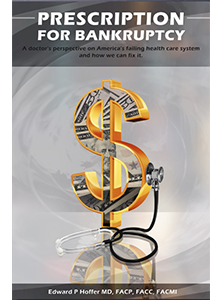
Doctor: Why Medical Costs Keep Going Up

“We are rapidly approaching the point where we will simply be unable to afford medical care,” says Dr. Edward Hoffer. This is no exaggeration, according to the Henry J. Kaiser Family Foundation: health insurance deductibles and copayments are rising so fast that a significant share of working families have great difficulty paying for their care.
“We as a society have to decide whether healthcare is a right or a privilege,” Dr. Hoffer said. “I happen to think it’s a right. We can’t all drive a Mercedes but every American deserves to have access to healthcare.”
His book, “Prescription for Bankruptcy,” provides his insider’s view of why healthcare costs keep going up. For 46 years, he has worked in Massachusetts as a cardiologist, public health official, and hospital and private practice administrator.

Question: How do U.S. medical costs compare with other countries?
Dr. Hoffer: The U.S. spends roughly twice as much per capita on healthcare as most other countries. Switzerland is nowhere near us, and they’re more expensive than the rest of Europe. Canada, Germany, France – they all have excellent healthcare systems and spend about half per capita what we do.
Q: What does this have to do with patient care?
A family policy costs the employer roughly $20,000 per employee per year, and many employers have been reacting by increasing employees’ deductibles and copays. If you’re the line worker who’s making $50,000 and you’re faced with a $5,000 deductible, you behave like somebody who doesn’t have insurance. You skip your preventive care or you avoid a medication because all of this comes out of your pocket. Women are deciding not to get a mammography or someone who has a colonoscopy recommended to them looks at the prices and says, ‘Maybe I’ll put it off.’
Q: You criticize high pay for hospital administrators. You once visited a Boston hospital CEO whose office was so large that you “could barely see him at the far end.” But aren’t administrators crucial to the system?
When I started in this business, the hospital had an administrator, a chief financial officer, and a director of nursing. Now you have a whole phalanx of people in the C-suite who all have to justify their existence. Hospital CEOs are similar to the CEOs of Fortune 500 companies in that the hospital board is composed of people they handpicked. CEOs will argue, ‘We’re running this complex enterprise – and look at what the CEO of Beth Israel is making. I should be making more than him.’
Hospitals keep getting bigger, but it’s not like making more widgets. The larger the organization gets, the more they add administrative costs while adding very little value to the organization, because the doctor and the nurse – not the administrators – are at the center of patient care.
Q: Health Affairs reports that one in five emergency rooms overbill or send out “surprise bills.” How does this happen?
E.R. billing is, to be perfectly blunt, often borderline fraud. Even if you come into the E.R. with a sore throat, you can end up with a level 4 visit on a 1-5 scale, which costs more money. They do it because they can. One of the things electronic records do is make it easier for doctors to act as if…they’ve done a comprehensive visit for higher insurance reimbursements. In the old days, if you were hand writing your notes, it was easier just to write down only what you did.
Q: Why are E.R. visits so expensive to patients?
A lot more insurers are saying they won’t pay for an E.R. visit for non-critical illnesses. For the same level problem, you could have gone to a minute clinic or doctor’s office for $100, and an E.R. visit is $1,200. The insurers, understandably, actively discourage them. If someone has chest pain, that’s a legitimate reason to go to the E.R., but if the doctor says this is just gastritis and sends you home, the hospital codes it as gastritis, and the insurer says, ‘That wasn’t an emergency, and we’re not paying for it.’
Q: How do out-of-network doctors and other providers make emergency care more expensive?
One way insurers cut their costs is by having narrower networks. They say to the hospital, ‘If you want to be part of our system, you have to accept our fee schedule.’ The agreement they negotiate binds the hospital but not necessarily the doctors. Then the insurer goes to the doctors and says we’re going to limit our network – we can have five pulmonary specialists, two rheumatologists, eight cardiologists, etc. If the doctors want to be in this network, they agree to the fees. But E.R. doctors and other specialists know their patients are a captive audience and will come to them whether or not they’re in network. They do not sign up for the network, and they bill what they want, often 50% or more above what the insurer will pay.
Q: What about spiraling drug costs?
The pharmaceutical industry is one of the most profitable in the world. Some high-priced drugs are brand new, innovative and took a lot of work. And while I think they’re overpriced, you can at least make an argument that they treat something we couldn’t treat before, such as these new genetic treatments. The main reason people get in trouble paying for medications is that the drug companies keep hiking the prices every year by more than inflation or even healthcare costs. Insulin is the poster child. Canadian doctors Banting and Best developed insulin in the 1920s. They said it was so important and lifesaving that they sold the patent to the University of Toronto for a dollar so it would always be available to diabetics. Now we see diabetics who are rationing their insulin because they can’t afford it. This isn’t a terribly different product than Banting and Best found 100 years ago.”
Q: Can patients with steep deductibles who are more exposed to high medical bills negotiate down the price?
It’s pretty tough. The only way you can really get out of it is to be dead broke. Then the hospital will write it off and call it free care. If you have any money, they’ll hound you. We’re probably the only western country where people go bankrupt because of medical care.
Q: Why don’t some of the advanced technologies embraced by hospitals and doctors make sense to you?
Technology is sexy. A hospital that uses robotic surgery can put billboards up saying, ‘Come to us, we have the latest and greatest.’ But while the latest and greatest is expensive, it is not necessarily better than what we’re already doing. Recently, the Food and Drug Administration put out a warning that doctors shouldn’t use robotic surgery for breast cancer – that the outcomes were actually worse. In prostate surgery, where technology is really pushed, there’s no evidence it’s better than the traditional way but it’s more expensive. Many things that are sold as improvements are only marginal in their improvements while hugely more expensive.
Squared Away writer Kim Blanton invites you to follow us on Twitter @SquaredAwayBC. To stay current on our blog, please join our free email list. You’ll receive just one email each week – with links to the two new posts for that week – when you sign up here. This blog is supported by the Center for Retirement Research at Boston College.
Comments are closed.







Just this week, the Rolling Stones’ Mick Jagger, a British citizen, chose to come to the US for heart valve surgery rather than getting it done for “free” in the UK. He was able to escape the inadequate British healthcare system unlike Alfie Evans and Charlie Gard, two sick British children of much more modest means, who were recently both forbidden by the UK National Health Service from seeking treatment in the US even when the American doctors offered their services for free and the travel was funded by a GoFundMe account. If fully funded access to the US healthcare system becomes a right for all, ask yourself where will the rich and connected go to get the best healthcare? What will become the new enclave for the elite? Presently, the 93% of Americans with health insurance can and do receive the same treatment at the Mayo Clinic, Sloan Kettering and Johns Hopkins as the rich and privileged. In order to make up that 7% gap, are we willing to make a two-tiered system where the best healthcare is inaccessible to the 93%?
Someone needs to have the courage to take on the AMA. Insurance companies and medicare should allow people to go abroad for major surgery and should hand out Green Cards to foreign doctors.
December 24, I was gassing up for a road trip and saw a man in a wheelchair at the end of the parking lot. I moseyed over to say hello: he was denied a kind of surgery in Canada so he came to the US and was so happy he is on his way to recovery. TRUTH.
The military – industrial complex has morphed into the military-industrial government-health care-big pharma-big ag-big finance-big school-big church-big media-big science complex, and has infected every aspect of life.
We have become what we hate, and now, we hate us, and for damn good reason.
The propaganda from politicians in every state and station makes that self evident.
Back to the interview, a huge portion of that 93% with health insurance can barely afford their deductibles, let alone services at the Mayo Clinic or Sloan Kettering. If they do avail themselves, they are saddled with debt that follows them for the rest of their lives. Thus, as the article mentions, many skip even preventive care and medication. In addition, as Dr. Hoffer states, insurers cut costs by narrowing their networks of providers — I doubt that everyone who is insured can hop over to the top clinics to receive the US’s “best” care. And talk about tiers? Check out the health insurance of federal employees and government workers compared to non-public union employees. The gap between tiers is enormous. Without doubt, our system is terribly broken. A nice thought: just think about how much money we could put back into actual care by eliminating a good portion of the health insurance industry’s profits.
Add to this list: dental costs, nursing and care homes and medical equipment too.
With an aging population over 16% of US total population this is not sustainable. AARP and others need to advance better and different models than status quo that is grounded in greed, fraud and waste — and now technology with little value, higher costs and questionable innovation. Healthcare is not a privilege in a quality society ahead.
How about eliminating health insurance altogether and just pay a standard fee. The reason the man from Canada was refused a surgery is most likely because it was not urgent. Emergency and life threatening disease is treated ASAP there. I am a nurse and I was in surgery. I am fully aware of how the Canadian system and European systems work. If you have a minor surgery, it will be treated, but you might have to wait. Cancer is treated soon and emergencies are first. Age may also play into some decisions. It might interest everyone here to know that Mexico has universal healthcare–two tiers in fact.
PS I’m was so thankful the day I went on Medicare, I can’t tell you. And I am happy still. No more hours and hours of dealing with the insurance company, correcting bills, questioning invoices, being astounded by deductible increases and skyrocketing premiums while services are reduced. Unfortunately, I have to witness my poor children put up with the same disasters (e.g. $2,000 out-of-pocket for a visit to the ER for stitches, $5,000 deductible …note: urgent care centers were closed) The amount of administration, paperwork and haggling that private insurers pushed onto local health care providers and insureds is beyond shocking. Our lovely “capitalist” system of health care is neither competitive or transparent — and the reason we’re stuck with it is the amount of power our campaign financing system gives to big health insurance/big pharma lobbyists. Whether you like government, hate it or are somewhere in between, we need a single payer system that offers decent care without bankrupting the middle class who don’t have a public union’s leverage to negotiate benefits. It would be one thing if our private insurance system made health care better for Americans. It clearly doesn’t.
The excessive administration, paperwork and haggling (and cost!) is because of government intervention and regulation in the healthcare industry. It is because of the greed of politicians and big union bosses who want to control big dollars and increase their own power. If health insurance was allowed to be competitive and offer services people actually wanted and needed, the cost would be much lower and service would improve.
Nope. Nothing to do with government intervention, everything to do with a complete lack of transparency in actual cost vs. pricing. And, multiple companies all haggling over who owes what to whom, happy in the knowledge that, ultimately someone else (the patient) pays anyway.
While I personally prefer government to generally not be involved in my life, the reality is that those countries where the government has got involved have healthcare costs half ours. Most of those countries also have longer average lifespans than the US does, so maybe their healthcare isn’t so bad after all.
And Mick Jagger, nice guy that he probably is, is not the best person that the Average Joe can relate to. My guess is that he paid more for his US medical work than you’d be willing to pay. Unless you’re a rock star too.. 🙂
Jennifer and Marcie hit the nail on the head. Not 1 Brit or Canadian in 100 would change their system for ours. Details in the book, but while a lucky few in this country get great care, many get mediocre care. Serious conditions treated promptly elsewhere while there are clearly waits for more elective care, and no one has to decide between medicine and food or clothing.
So let’s look at the math: the U.S. now spends $3.4 trillion on health care annually, at about 19% of GDP; it is higher than federal sending at $3.1 trillion, so the two combined represent almost 40% of GDP and is growing faster than annual inflation. Eventually it will overtake the economy and lead the country to bankruptcy because the rest of the economy can not support it. Lastly, the health care lobby on K Street spends $500 MILLION annually buying and owning Congress to vote what they want; $500 million is chump change to own $3.4 trillion in spending. U.S. health outcomes are no better than in Europe and they spend HALF of what we do.
I understand this is highly anecdotal, but offer it for your consideration because I have not seen it addressed here. My best friend is a hospital administrator and my next-door neighbor is a practicing OB-GYN physician. Both of them blame health care costs on malpractice insurance, claiming that it’s the incredibly large numbers of lawsuits that drive up the cost of malpractice insurance and that is the single biggest line-item cost they face. Anybody who has watched tv for more than 5 minutes has seen a commercial for medical class action lawsuits…right?
My husband and I have had Medicare Advantage plans for the past few years and have been happy with them. However, the drug costs have really escalated….tier 2 drugs are now tier 3, etc. We have found that using a discount drug program such as GoodRx saves us a lot of money. Unfortunately it is inconvenient for our doctors when they ask “who is your pharmacy?” We have told them that we have to shop around before they send the prescription.
FACT: No child in the US goes without needed medical treatment regardless of their ability to pay. This is true even if the child is not a US citizen! Through a combination of insurance, government & charity all children in the US have access to the best healthcare that ever existed. Meanwhile, in countries with universal healthcare schemes children are routinely denied treatment by bureaucrats and some die as a result (google Alfie Evans or Charlie Gard).
FACT: In the US, the decision to pursue any treatment is made by the patient, not by a government panel. If you want to spend everything you have and go into debt to receive a particular treatment you have the freedom to choose and there are providers willing to help you. By contrast, in Britain, for example, you will be threatened with jail for trying to leave the country to obtain treatment the government has denied for your terminally ill son (again, google Charlie Gard).
FACT: 93% of American adults have full and complete access to the healthcare services available to everyone in the country. The choice of how to access it lies with each individual. The alternative to some patients going into debt for treatment is not that it can somehow be provided for free for anyone who asks. The alternative is that the some faceless bureaucracy will decide who will live and who will die based upon purely budgetary reasons.
FACT: Foreign countries with universal healthcare schemes are entirely dependent upon the US health system to sustain themselves. US healthcare consumers subsidize European healthcare by paying higher prices in the US to compensate for price controls in those other countries. The US produces most of the medical equipment & drugs and almost all of the innovation in healthcare because foreign countries can’t afford to spend toward those things. The best and brightest doctors in foreign countries almost always leave and set up practice in the US leaving only the bottom tier professionals in those countries.
Americans live in an unbelievable paradise of healthcare not only in vast variety but in excellent high-quality service. This exists nowhere else. There is indeed greed and abuse in the system, but also a stunning amount of compassion, innovation, equality and (yes!) fairness. Americans will never trade that for universal mediocrity.
I may be in the minority because I don’t think doctors are paid nearly enough for the responsibilities they shoulder. The average salary of a primary care physician in the US is less than $250,000. Not all that much, when you consider the years of schooling and depth of knowledge they need.
The problem with the US healthcare system isn’t doctor reimbursements, but rather all the middlemen who suck up our health care dollars like crazed vacuum cleaners. And, of course, politicians who talk a good game but block Medicare from negotiating drug prices.
My experience is a good example. There’s an entity that stands between the doctors and my insurance company. Supposedly, it’s a regional “not for profit” hospital network that operates hospitals, clinics, and so on. This organization bills patients and collects reimbursements from the insurance company. So far, so good.
Unfortunately, whenever there’s a plan discount involved–in other words, when I use a “preferred provider”–this “entity” keeps billing me for that discount. Over and over, month after month. Doesn’t matter how many times I email copies of the insurance company’s Explanation of Benefits, or talk to one of their “customer service representatives.” Doesn’t even matter if the insurance company itself intervenes on my behalf (which it’s done, more than once). The bills keep coming, followed by collection agency threats.
As a result of all the mental stress this “healthcare” organization causes me, I admit I’ve put off wellness visits. In fact, at this point I pretty much have to be dying before I visit my doctor anymore and risk months of billing aggrevation.
Now here’s a truly ironic tidbit that puts US healthcare problems into perspective. Remember that average primary care physician’s salary I mentioned earlier? Compare that number to what the CEO of this “not for profit” hospital network pulled in last year: over $6 million dollars! (Two years ago, he “only” raked in $5.4 million. Nice raise, wouldn’t you agree?)
Makes you wonder why ANYBODY would bother going to med school anymore.
I am traveling this week in Morocco with an American tour company. Most of the 22 travelers are in their mid 60’s and over. We had two incidents were medical services were required. One person fell backwards and hit their head on the floor of the motor coach as it pulled away. It was a hard fall. After some discussion, it was determined that since this person was on blood thinners and had a sibling that recently died from an aneurysm, a CT scan was required. The nearest hospital that had the equipment was 3 hours a way. They hired a taxi and the tour company hooked them up with an interpreter. The scan was done and read by two doctors who conferred that everything looked fine. 1300 Durham later ($130), they met the tour group at the end of the day. Keep in mind the CT is not old and is not made in Morocco. The other person was having problems with low blood pressure. Their US doctor wanted an EKG. The doctor here in Morocco and the US agreed that patient would most likely need a pacemaker. Bill: $60. The profit motive in ever aspect of our culture is killing us!
Good article and comments here; I haven’t digested everything and hope to reread. Perhaps we need more places like Surgery Center of Oklahoma with its transparent pricing.
Good article and comments here; I haven’t digested everything and hope to reread. Perhaps we need more places like Surgery Center of Oklahoma with its transparent pricing.